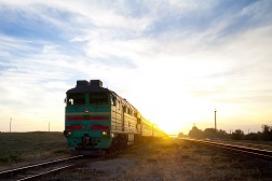Private Investments Position Freight Rail Network for Future Success
Andrew Johnsen, assistant vice president for Government Affairs at BNSF Railway and alum of the U.S. Department of Transportation, shared his insight about the U.S. freight rail network during a talk at his old stomping grounds: Volpe, The National Transportation Systems Center.
There are 568 freight railroads in the United States, including seven Class 1 railroads:
- BNSF
- Union Pacific
- Canadian National
- Canadian Pacific
- Kansas City Southern
- CSX
- Norfolk Southern
BNSF is now the largest railroad in the country, operating in four "cornerstone" areas: the Pacific Northwest, a northeast corner around Chicago, Texas, and the Powder River Basin in Wyoming.
Johnsen described a dynamic U.S. freight rail network. Railroads move about 40 percent of America’s freight over 140,000 miles of track and provide jobs to more than 220,000 employees nationwide. While the U.S. moves more freight than any other freight rail system in the world, Johnsen articulated several major challenges facing the rail industry, including the following:
- Fuel efficiency
- Environmental solutions
- Highway congestion
- Rail capacity
- A shortage of drivers
- Climate change and flooding
Johnsen pointed out that railroads require huge capital investments to survive. U.S. freight railroads have invested $12 billion per year to preserve, maintain, and grow capacity, plus another $10 billion on locomotives and rolling stock.
"We’re a very private sector,” he said. “Trains operate on an infrastructure built and financed almost entirely by private railroad companies.” BNSF has invested an average of $3.4 billion in capital annually for the last 10 years. About half of that has gone directly to tracks; the rest goes toward locomotives, other equipment, and expansion.
Market conditions require adaptability in the rail industry. “Despite constant flux in the market, BNSF is charging ahead with new customers and plans for radically altering its fuel consumption,” said Johnsen.
“Another profound initiative we’ve undertaken is changing how we fuel locomotives,” said Johnsen, explaining that BNSF plans to invest a total of $6 to $8 billion in transitioning to liquefied natural gas. “We’ll be able to convert a large portion of the fleet.”
BNSF is also adjusting to the impacts of a changing climate. “Our agricultural sector recently dropped, due to droughts,” explained Johnsen. But in 2008, BNSF took the initiative when fracking techniques opened up the Bakken Shale, large oil reserves covering parts of Montana, North Dakota, and Saskatchewan. “There aren’t any pipelines, so rail is filling the gap,” explained Johnsen. “BNSF now hauls 700,000 barrels a day out of the Bakken fields with the capacity to haul even more.”
BNSF is also involved in being a good neighbor along the Great Northern Corridor—a traditional rail corridor extending from Seattle, Vancouver, and Portland to Minneapolis and Chicago. “There are a lot of towns along that route that no longer provide rail jobs, but they still have to deal with the impacts of trains coming through. We already have some investment in those areas. We’re looking at how we can help them see some economic benefits from rail.”
In response to a question about the greatest change of all coming down the line—climate change and associated flooding—the railroads are ready to adapt, as always, said Johnsen. After all, he pointed out, “It’s easier to raise a rail track than a freeway.”

